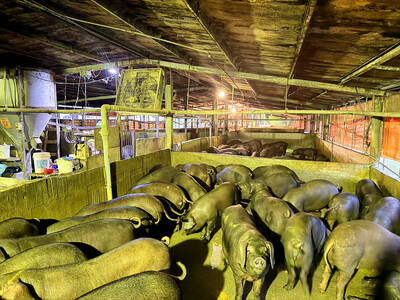Shuangsi River forms the upstream section of Meinung River on the ***outskirts*** of Kaohsiung’s Meinung District and is reachable in 15-20 minutes by vehicle from the center of Meinung District.
The Shuangsi Tropical Arboretum trail is located next to Shuangsi River within the Shuangsi Tropical Viviparous Forest Reserve. Three interconnecting paths converge within the 7.65 hectare-wide forest reserve, of which the Big Tree Forest Trail is the main route, while the Big Leaf Mahogany Trail and the Birdwatching Trail form two secondary routes.
The approximately 1.5km walk takes you from the park’s entrance to scenic ***grasslands*** at the end of the trail. The ***elevation*** varies only about 100 meters along the route, while there are a large number of rest areas and seats along the well designed trail, which means that the walk is not too taxing, yet passes through ***dense*** forest.

雙溪熱帶樹木園步道,二○一五年七月三十日攝於高雄美濃。
照片:自由時報記者陳祐誠
It is recommended to take the Big Tree Forest Path to ascend the mountain. Along the way you will pass through ***tropical*** forests of elephant apple trees and rain trees in addition to small bridges, tiny flowing streams and if you keep your eyes peeled, you may spot the charming sight of crawling hermit crabs.
After a 30-40 minute walk you will reach a scenic grassland area, which although is not the wide open ***pastureland*** one imagines ― but is instead a grassy resting area ― nevertheless wooden seats and a small discarded push car are available to rest and ***admire the view***.
Following a short rest, you could take a detour while descending the mountain and take the Birdwatching Trail which passes through forests of ceylon olive and teak trees before connecting onto the Big Leaf Mahogany Trail to finish the descent down the mountain.
(Liberty Times, translated by Edward Jones)
高雄的美濃雙溪位於離美濃市區約十五至二十分鐘車程的郊外,其為美濃溪的上游。
雙溪樹木園步道就位在鄰近雙溪旁的雙溪熱帶母樹林中,在這座廣達七點六五公頃的樹木園中,裡頭設有三條彼此可交接匯集的步道,以巨木林步道為主線,另有大葉桃花心木林、賞鳥步道兩條副線。
從入口處走至步道終點的觀景草原長約一點五公里,海拔落差僅約一百公尺,加上步道規畫完善、沿途也設有不少休憩平台和坐椅,所以走起來難度不高,但林相卻很豐富。
建議可走巨木林步道上山,沿途行經第倫桃樹、雨豆樹林等熱帶林上山,步道間有小橋、小溪流,仔細觀察還會發現陸蟹爬行的可愛身影。
約花費三十到四十分鐘腳程直上觀景草原區,草原區雖不似想像中的寬廣草原,而是一個休憩的草坪區,但草坪上擺設有木椅和一座廢棄的可愛小台車可供休息和觀賞。
稍做休息後,下山時可順道繞往賞鳥步道穿過錫蘭橄欖林和柚木林,最後再接大葉桃花心木林步道下山。
(自由時報記者許麗娟)

For many people in Taiwan, childhood memories of rural life include pig pens standing beside family homes. Leftover rice, vegetable scraps and soup from daily meals were poured into buckets and fed to pigs. This practice of feeding pigs with household food waste was once a common way of life, both an economic choice and an expression of agricultural society’s deep respect for conserving resources. From a practical standpoint, pigs are omnivorous animals capable of efficiently digesting food scraps that humans can no longer eat. For rural households, food waste cost almost nothing, yet it could be converted into pork, a

A: Apart from the world’s major dictionaries, the online Dictionary.com actually picked “67” as its word of the year. B: What does “67” even mean? A: Even the dictionary wasn’t exactly sure about its meaning. The slang term’s origin might be traced to US rapper Skrilla’s song Doot Doot (67). Aren’t Taiwanese media outlets choosing the Mandarin word for 2025? B: Yeah and after hearing the song Good-for-Nothing, adapted from some catchphrases of Legislator Wang Shih-chien, I’m going to vote for the character “tsung” (hasty) from the lyrics. A: Hopefully, in the new year, we’ll be calm as the

Sea star wasting disease (SSWD) is a strange and serious illness affecting sea stars, or starfish. This disease causes sea stars to develop painful lesions, lose their arms, and eventually turn into a gooey, melted mess. Since it was first observed in 2013, millions of sea stars along the Pacific coast of North America have died from this __1__. Although viruses were once considered a possible cause, researchers now believe that environmental stressors and microorganisms are primarily __2__ for sea star wasting disease. One of the main environmental triggers appears to be warmer ocean water. When the water heats

Continued from yesterday(延續自昨日) https://www.taipeitimes.com/News/lang The loss of sea stars significantly impacts the ocean ecosystem. Sea stars are important __6__ that help control populations of mussels and sea urchins. Among them, the sunflower star is one of the largest and fastest sea stars and is adept at preying on sea urchins. Without sea stars, sea urchins can __7__ in numbers and devastate kelp forests. These forests are essential __8__ for many marine animals and also help capture carbon from the atmosphere, which is vital in the fight against climate change. The mystery behind SSWD is still __9__, but it is clear that